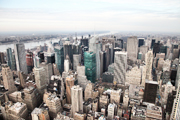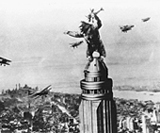Manhattan's feeling heart barely needs introducing. Even though it was designed to host offices and tourists, the Empire State Building now has two very important extra jobs to do: To hold the city together and to reflect how its people feel. In order to hold the city together, it just stands on the intersection between Fifth Avenue and West 34th Street, rising 1,250 feet over the ground, being visible from most of the city, reminding them that for almost a century they had the the tallest building in the world.
But it also reflects how its citizens feel: when in New York City, make a point to observe the floodlights which every night comment of the city's mood with different colors. They stayed red, white and blue (the colors of the American flag) for months after the September 11th attacks; they turned blue in mourning when Frank Sinatra died (Sinatra was known as "Ol' Blue Eyes"); but also they turned yellow when the Simpsons movie came out, and then red, yellow and red to honor the Spanish flag when Spain won the World Cup in 2010.

There is the option of seeing the skyline from the top of the building. It's not a bad idea per se -- some say you haven't seen the city until you have seen it from the observatory on the highest floor -- but you can get the same result from other, more comfort-friendly venues.
The rooftop bars of many hotels (may we recommend the High Bar at the Gramercy Park Hotel at 2 Lexington Avenue?) offer a very similar view of New York's unequalled skyline with the the added benefit of a good rest, a rejuvenating drink and no hordes of tourists pushing you around 1,250 feet from the ground.
Another benefit is that you don't have the to hear the urban legend about people committing suicide during the Great Depression by jumping off the observatory. The truth is, the building didn't open until 1931 (two years after 1929's Wall Street crash) and so this is mostly false.
There's a much better Depression-related joke in the fact that the site and the excavations, done in 1920s economy, cost 41 million dollars and then the cost of assembling the building itself, in 1930s economy, amounted to 24,000 dollars. But its cost is just a small part in a particularly dense string of stories adding to the building's legend.

Perhaps the most famous one is the one where a ten-ton B-25 fighter crashed against it on July 28, 1945, just after World War II had ended. The plane was heading for Newark but the pilot got lost in the thick fog of that Saturday night and he would only regain visibility to find himself flying directly over a forest of skyscrapers. He surprisingly managed to dodge several of them, but he couldn't avoid the Empire State Building. He tried to fly over it, but it was too tall, and ultimately crashed against the 79th story, right into the offices of the National Catholic Welfare Council. Eleven workers died and the three crewmen were reduced to ashes. The building wasn't affected by the impact.
Most of the publicity around the Empire State Building tends to hark back to the classic scene in 1933's film version of King Kong, where the giant ape climbs to its roof in order to protect the girl he's carrying in his hand, and is subsequently shot down by light aircrafts. It's a hardly reprehensible choice on the advertisers' part. The scene is visually mesmerizing and is almost impossible not to be reminded of it when one sees the building.
However, no brochure will tell you the most charming story to come out of it.
It happened in 1983, in the movie's 50th anniversary. By then, time had taken some of the glamour off the Empire State. Past its prime, run down, no longer the biggest kid around, it needed something to zest up its image. Something to remind people of what it once had been. Enter a Californian called Robert Keith Vicino, an expert in designing giant inflatable advertising displays.
Vicino contacted the owners of the building with a plan: he could provide them with a life-size, 130-foot tall King Kong balloon they could then hang on to the Empire State's facade to celebrate the movie and generate publicity for the building. Making the Kong, he added, would cost about $100,000, but he was willing for pay for it himself as long as he got to be on television. The Empire State staff would only have to hang it on top of the building for ten days. Just enough time for the sight to travel round the world and revive the legend. It seemed a lucrative deal. The Empire State people agreed.

Come April 7, when the stunt was to be pulled, King Kong looked rather flaccid. His armpits had ripped and he could not be inflated back to his fearsome glory. He did, however, rock from one side to another following the wind. With every swing, he would break a couple of windows. The Empire State owners, Harry Hemsley (millionaire hotel manager) and Leona Hemsley (ex waitress, imminent rich widow-to-be and, by and large, a character of notorious perfidy), had rented a few bi-planes to add realism to the recreation and they were not going to leave them on land. So for the best part of a day, a couple of small planes flew in circles around the top of the Empire State, from which a dark, shapeless contrivance kept swinging to one side and then other.
Up to eight days and $650,000 (ironically, the original movie's budget) were necessary to repair King Kong's armpits. Finally, on April 14, the beast rose and for a while looked impressively like the real thing. Some minutes later it ripped again, recovered its ragged guise and was subsequently removed and forgotten.